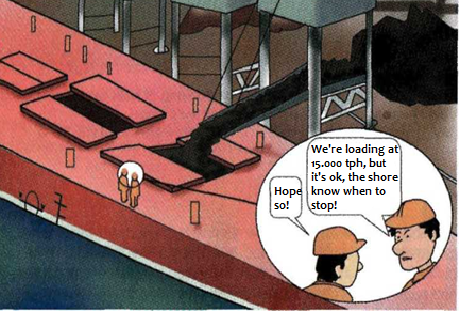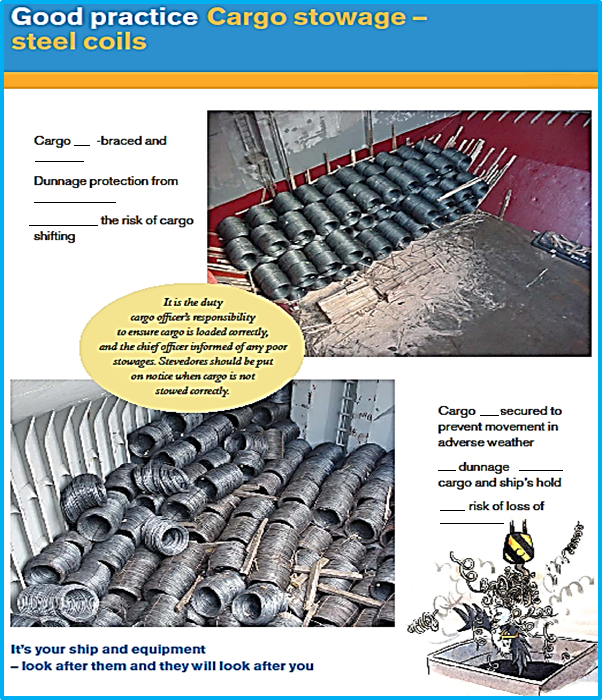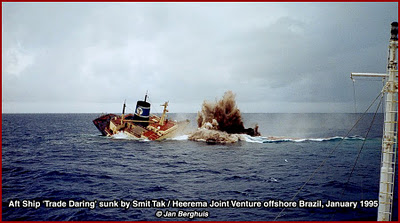
- •Vocabulary
- •Sweep, stow, remove, rinse, support, taint, promote, prevent, facilitate, dry, wash, mop out, ventilate.
- •Later, after that, then, in some days…
- •Cleaning of Holds
- •Allow Sufficient Time Or It Will Be Costly
- •Topic 2 Stop-loss Practice
- •If you worked on a bulker speak about real safety precautions as to the cargoworks.
- •What will such practice lead to?
- •Loading Cement: Make Sure You Clean Up After Loading
- •Word List Unit 1 Bulk Cargo Handling
Topic 2 Stop-loss Practice
Starter
a) Read the case and find who or what is to blame.
According to Jan Berghuis, "250 kilograms of explosives were needed to sink the broken bulk carrier. What you see on this picture is not the actual explosion. It is ore coming out of the collapsing hatches during sinking." |
The OBO Trade Daring broke in two at the same location due to incorrect loading- literally snapped in half - whilst loading iron ore at Ponta da Madeira on November 11, 1994. Their deepwater pier was obstructed for more than six weeks while the wreckage was removed. The vessel ended up in two sections, which were scuttled off* the coast of Brazil. |
Notes
* scuttled off - removed
b) Discuss.
Why did the accident happen?
How was it possible to avoid it?
Why did they decide to blow up the Trade Daring?
If you worked on a bulker speak about real safety precautions as to the cargoworks.
Reading
1 Are the sailors just joking?

2 Read and prove that the picture above fits the text.
|
Cargo Management Cargo must be discharged or loaded as efficiently and safely as possible. This is the prime aim and I am sure would be recognised by both ship and port as such. The ship must prepare and agree with the berth or terminal the cargo load or discharge programme. It is then the obligation of the berth to follow that, with any changes owing to equipment failure agreed by the ship. |
In the past it was accepted practice that the ship was loaded to the Captain's requirements and many Charter-Parties stated this. However, there are many terminals or berths where this is reversed so the ship must load to their instructions. The ship is in a difficult position in these circumstances. It must either agree to load as the port or berth requires or risk the port refusing to berth the ship or blacklisting the ship or Captain on future occasions. On the other hand, the Captain has an obligation to place the safety of his vessel and crew before all other interests. For example, a common problem is a dispute regarding bulk carrier loading rates, with some ports wishing to constantly increase them, regardless of the age or state of the ship. Although there have not been any conclusive findings on the effect of this rate of loading on the steelwork and stresses on the vessel, you should assume the worst and err on the side of safety. |
|
By Captain M. Lloyd
In Command
3 Agree or disagree with the undelined statements.
4 Debate!!!
What will such practice lead to?
“…a common problem is a dispute regarding bulk carrier loading rates, with some ports wishing to constantly increase them, regardless of the age or state of the ship.”
5 Complete the English phrases.
Loading capacities and quantities |
Грузовместимость и количество груза |
1 What is the _____________ of the vessel?
- The ________________ is ... tonnes. |
1 Каков дедвейт (полная грузоподъемность) судна? - Дедвейт - ... тонн. |
2 What is the hold / bale / _________________ of vessel?
- The hold / bale / ________________ is ... cubic metres. |
2 Какова вместимость трюмов судна / киповая вместимость / вместимость для зерновых грузов? - Вместимость трюмов / киповая вместимость / вместимость для зерновых грузов составляет ... куб. метров. |
3 How many cubic metres of cargo space _____ ______________? - ... cubic metres of cargo space are required. |
3 Сколько требуется кубических метров грузовместимости? - Требуется ... кубических метров грузовместимости. |
4 How many tones / cubic metres can the vessel __________? - The vessel can still _______ ... tones / cubic metres. |
4 Сколько еще тонн / кубических метров может погрузить судно? - Судно может еще погрузить ... тонн/ кубических метров. |
5 How much ________________ can the vessel load? - The vessel can load ... tones / cubic metres / containers on deck 20'/40'. |
5 Сколько палубного груза может принять судно? - Судно может погрузить на палубу ... тонн / кубических метров / ... 20/40-футовых контейнеров. |
6 What is the size of the _______ openings? - The size of the _______ openings is ... by ... metres. |
6 Каков размер люков? - Размер люков ... на ... метров. |
7 What is the safety load of no. ... hold? - The safety load of the ... deck of no ... hold is ... _____________________________.
|
7 Какова допустимая нагрузка трюма № ...? - Допустимая нагрузка палубы трюма № ... - ... тонн на квадратный метр. |
6 Correct the spelling mistakes if necessary.
a. The size of the hatches openings is 4 by 10 metres.
b. What in the bale capaciti of vessel?
c. The safety load of the cargo deck of the sixth hold is six tonnes per square metres.
d. The vessel can load 2000 cubic metres on deck.
e. What are the sizes of the hatch opening?
f. Six thousand cubic metres of cargo space is required.
g. The vessel can still load 1.5 tones.
h. The grain capacity is 4500 cybic miters.
7 Transfer the messages into SMCP.
1. We can load five tonnes more.
_____________________________________________________________________
2. What are the hatch dimensions?
_____________________________________________________________________
3. The total weight of cargo, stores which a ship can carry is 10.000 tonnes.
_____________________________________________________________________
4. What weight can the hold five stand?
_____________________________________________________________________
5. The second hold can take in three tones of grain.
_____________________________________________________________________
6. The length and width of the hatch cover are five and ten meters, respectively.
_____________________________________________________________________
Reading
8 a ) Decide which photos depict good and bad practices?
b) Restore the descriptions.

9 Discuss.
a. Did you follow the recommendations above?
b. Who was in charge of cargo loadingdone correctly?
c. Did you have any accidents connected with poor cargo loading?
d. How did the Master participate in all process of cargo handling?
e. Did you perform any cargoworks that should have been done by others?
f. Is it really important not to lose reputation in cargo transportation? Why? Why not?
10 Read the case and find who or what is to blame:
Cargo officer
weather
Agent
stevedore
Master
small loading chute


